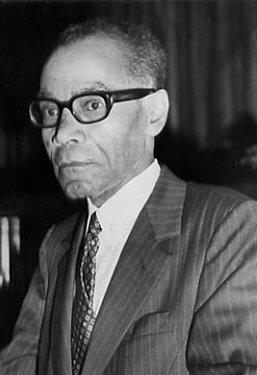Léon Damas facts for kids
Léon-Gontran Damas (born March 28, 1912 – died January 22, 1978) was a French poet and politician. He was one of the important people who started the Négritude movement. This movement was about celebrating black culture and identity. Damas also used another name, Lionel Georges André Cabassou.
Contents
Biography of Léon Damas
Léon Damas was born in Cayenne, French Guiana. His father, Ernest Damas, had both European and African family roots. His mother, Bathilde Damas, had Native American and African family roots.
Early Life and Education
In 1924, when Léon was 12, he went to Martinique for school. He attended a secondary school called Lycée Victor Schoelcher. There, he met Aimé Césaire, who became his lifelong friend.
In 1929, Damas moved to Paris to continue his studies. His parents wanted him to study law. However, he also took many other classes. These included anthropology, history, and literature. These subjects made him very interested in new political ideas.
Founding the Négritude Movement
In Paris, Damas met up with Césaire again. He was also introduced to Léopold Sédar Senghor. In 1935, these three young men started a literary magazine. It was called L'Étudiant Noir, which means "The Black Student."
This magazine helped start the Négritude Movement. This was a movement of black thinkers and writers who spoke French. They wanted to reject the control and ideas of Western culture. They celebrated black identity and heritage.
Poetry and Politics
In 1937, Damas published his first book of poems, called Pigments. His poems had a special style. He used the French language in new ways to break old rules of poetry. The collection talked about racism and problems in Western colonial culture.
Pigments explored how racism affected people of African descent around the world. The French government later banned Pigments. They said it was a "threat to the security of the state." But before it was banned, the book was translated and shared in many countries.
During World War II, Damas joined the French Army. Later, he became a politician. He was elected to the French National Assembly from 1948 to 1951. He represented French Guiana.
After his time in politics, Damas traveled a lot. He gave talks in Africa, the United States, Latin America, and the Caribbean. He also helped edit Présence Africaine, a respected journal about Black studies. He was also an adviser for the Society of African Culture and a delegate for UNESCO.
Later Years and Legacy
In 1970, Damas and his wife, Marietta, moved to Washington, D.C. He taught at Georgetown University during the summer. In his last years, he taught at Howard University. He also worked as the acting director of their African Studies program.
Léon Damas passed away on January 22, 1978, in Washington, D.C. He was buried in Guyana. Even though his political poems were less popular later on, Damas's reputation grew. His poems were very modern for their time. They sometimes played with how words looked and sounded. His work seemed to predict the black poetry that came much later.
Works
Poetry Collections
- Pigments. Paris: Guy Lévis Mano (1937). Paris: Présence Africaine (1962).
- Poèmes nègres sur des airs Africains. Paris: Guy Lévis Mano (1948).
- Graffiti. Paris: Seghers (1952).
- Black-Label. Paris: Gallimard (1956).
- Névralgies. Paris: Présence Africaine (1966).
- Mine de Rien. Collection of 36 poems. Washington, DC (1977), quoted in Christian Filostrat, Negritude Agonistes, Africana Homestead Legacy Publishers, 2008, ISBN: 978-0-9818939-2-1
Essays
- Retour de Guyane. Paris: José Corti (1938).
- Poètes d’expression française. Paris: Seuil (1947).
- Poèmes Nègres sur des airs africains. Paris: G.L.M. Éditeurs (1948).
Stories
- Veillées noires, Contes Nègres de Guyane. Paris: Stock, 1943. Montréal: Leméac (1972).
Recordings
- Poésie de la Negritude: Léon Damas Reads Selected Poems from Pigments, Graffiti, Black Label, and Nevralgies (Folkways Records, 1967)
See also
 In Spanish: Léon-Gontran Damas para niños
In Spanish: Léon-Gontran Damas para niños


